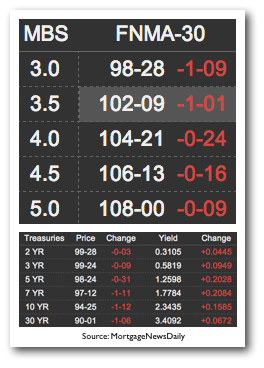Bernanke On Higher Mortgage Rates
 Fed chairman Ben Bernanke kicked off today’s rate policy press conference by saying monetary policy will continue to support recovery. But that wasn’t enough to calm markets. If anything, the rest of his comments and the earlier FOMC rate policy statement made things worse. Here’s the sea-of-red snapshot of bond markets following today’s announcement. Rates rise when bond prices drop like this. For example when the Fannie 30yr 3.5% coupon lenders use as a benchmark to price rates is down 1-01 ticks (a tick is 1/32) in this table, it means it’s down 103 basis points—a severe one day drop.
Fed chairman Ben Bernanke kicked off today’s rate policy press conference by saying monetary policy will continue to support recovery. But that wasn’t enough to calm markets. If anything, the rest of his comments and the earlier FOMC rate policy statement made things worse. Here’s the sea-of-red snapshot of bond markets following today’s announcement. Rates rise when bond prices drop like this. For example when the Fannie 30yr 3.5% coupon lenders use as a benchmark to price rates is down 1-01 ticks (a tick is 1/32) in this table, it means it’s down 103 basis points—a severe one day drop.
As for the rest of the press conference, below are other key notes. Given this sharp MBS selloff sending rates higher, let’s kick off with what Bernanke said about mortgage rates.
+++
On mortgage rates:
– Rates are rising (meaning bonds are selling) because of an improving economic outlook and perception of Fed actions.
– People expect house prices to continue to rise. Rising home prices compensates for a slightly higher mortgage rate. The change in mortgage rates is not all that dramatic. If interest rates go up for the right reasons—such as a better economy and accurate interpretation of Fed actions—that’s not a bad thing, that’s a good thing. [It’s debatable whether the .875% rise in rates since January is only “slightly” higher or “not all that dramatic”.]
On overall monetary policy:
– We have 2 policies in place now: Communicating about Fed Funds. And purchasing Treasuries and MBS (aka quantitative easing or QE).
– A strong majority of FOMC officials think Fed won’t sell MBS near term. As for a Fed Funds increase, 14 of 19 think an increase may be warranted in 2015.
– The 6.5% unempoyment is a threshhold not a trigger for adjusting the Fed Funds Rate. We’ll take a look at inflation at that time, and we’ll also see if that rate properly represents the state of the labor market (long term unemployment, etc.). Since it’s a threshold not a trigger, it means we can take all labor market factors into account, not just the unemployment rate itself. If we did adjust the threshold, we’d lower it, not raise it.
On Quantitative Easing (QE):
– Pace of QE purchases is unchanged at 40b of MBS and 45b in Treasuries per month now. We made no changes to program today. We may vary the pace of purchases as economic conditions evolve. The economic outcomes involve continuing gains in labor markets and headwinds diminishing. Inflation will also move toward 2% over time. If this happens, we’d moderate this accommodation, and reduce purchases (QE) in steps between now and mid next year. But we need a substantial improvement from 8.1% unemployment at the time QE3 was announced.
– Decisions on the pace of MBS/Treasury purchases (QE) is totally market driven.
– We’d be slowing the pace of buying but wouldn’t sell. We’d also continue to reinvest principal payments into new buys.
– We’d be taking our foot off the gas on the pace of asset purchases, not applying the brakes by raising short-term rates.
– It’s important not to peg policy to dates, it’s important to peg policy to economic conditions.
– As for threshold on unemployment as it pertains to making decisions about slowing QE, it’s more like 7%.
– Our intent was to use asset purchases (QE) is to create economic recovery momentum.
– There are two critical notes about our asset purchases: (1) Our target for ending asset purchases is maximum employment which is 5-6% unemployment, but 7% is a mile marker along the way. (2) Stopping asset purchases won’t involve ending the stimulus from asset purchases because we’re going to hold onto that portfolio and reinvesting principal payments, which will continue to help rates to bring economy smoothly toward full employment without incurring big risks to economy.
On the future of U.S. mortgage markets:
– Other countries mortgage markets are less government-subsidized yet they have same home ownership rates as the U.S. [This shouldn’t be given too much weight in terms of Bernanke advocating a position, the context was him simply answering a general question about the current structure of the U.S. mortgage market]
